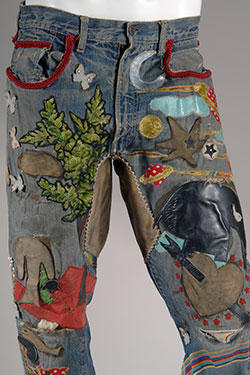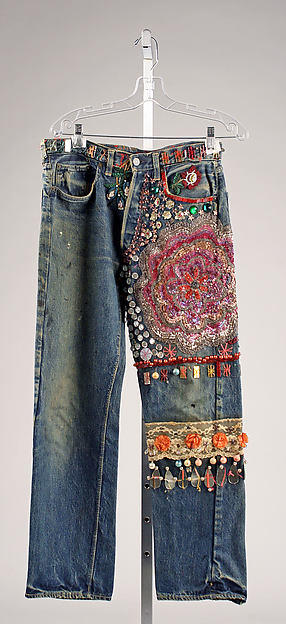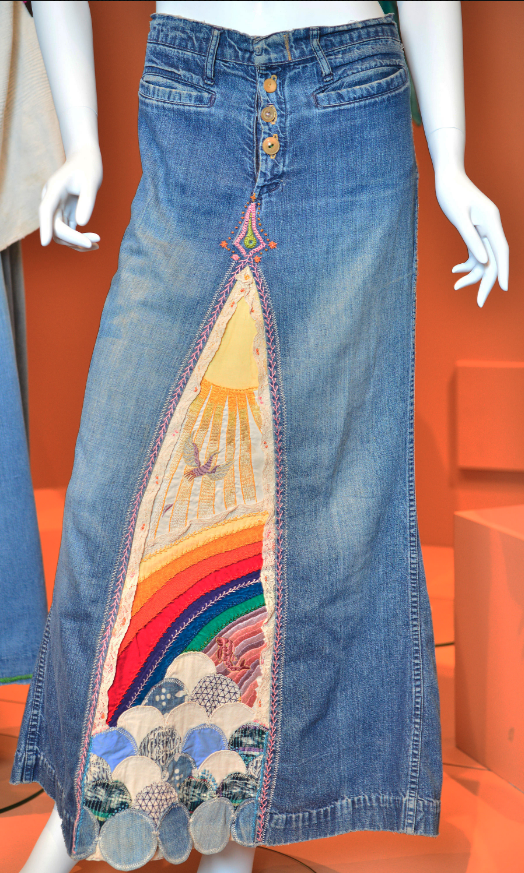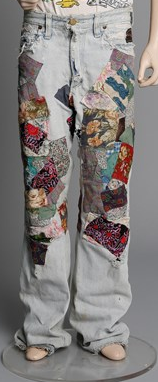Introduction
The 1960s and 1970s were a time of changes in the American society. Gone were the overly optimistic days of the 1950s and the youth of the day became focused on the social issues of the country. Self-expression became essential for most young people, and it was often reflected in their clothing. This exhibit shows some examples of this in the embroidered and patched denim clothing worn by people of the 1970s.
Brief History
The fashion of the 1950s was relatively strict and relied heavily on traditional ideas of gendered clothing. Men were expected to wear suits with hats, and women wore long dresses and skirts. With the exception of sub-groups, fashion was not primarily used as a source of self-expression. This is what made the fashion of the next two decades so revolutionary and iconic (Ewing 152). The youth of the 1960s rejected many of the traditional fashion choices of their predecessors.
Bright colors and groundbreaking ideas dominated this decade, especially in women’s clothing. Short skirts, dresses, and various types of pants became fashionable and accepted into the mainstream women’s fashion. This decade also marks the beginning of the Hippie movement which was famous for using its clothing for self-expression. The hippie culture emerged in the mid-1960s as a counterculture response to the culture of the previous decade and the political situation of the time. The world was in the midst of the Cold War between the United States and the Eastern Bloc which brought a variety of new issues to the world (Lewis 71).
The proliferation of nuclear weapons threatened the world with a nuclear war as the tension between the nations increased. Hippies opposed the culture that let the world get to this state, as well as civil rights violations, lack of environmental preservation and other negative outcomes of the conservative way of life. Their use of psychedelic drugs was reflected in the bright colors and intricate shapes used in their art and clothing. This culture grew even more in the 1970s due to the increasing opposition to the war in Vietnam and different conservative policies that were enacted at the time (Lewis 175).
The fashion of this sub-group was varied with both earth-tones and psychedelic colors being common on dresses, pants, and shirts. One of the popular materials of the time was denim due to its ability to withstand a lot of outdoor activity which was common for hippies. Denim shirts and denim jeans were worn by both men and women in the sub-culture. They were often customized with embroideries and patches to decorate and at the same time reflect the views of the person.
Hippies had a strong love for the environment and nature which was a common theme of the embroideries. Patterns of flowers, trees, rainbows, and various symbols were often seen on the hippie clothing. These designs were usually hand-crafted, as the sub-culture strongly believed in the DIY production. Patches of different materials were used to add color to the blank jeans. The colors would often clash with each other, but it was not seen as a negative.
New and original works were celebrated by the community, and due to its DIY nature, no two outfits were the same. Patches would also have a practical use (Armstrong 82). As mentioned earlier, hippies would often spend time in nature which would cause their clothes to slowly wear out from the activity. When the holes are small, they were not seen as an issue, but when they grew, a patch was used to cover them up and provide structural integrity to the outfit. The clothing of the Hippie culture is highly representative of their beliefs.
Exhibits

This pair of jeans can be seen as both a representation of the popular culture of the time, as well as an example of hippie clothing. The patches on the right of the image feature male and female symbols to express hippie beliefs of sexual liberation, as well as the peace symbol showing the anti-war sentiment. The flower represents nature and its beauty. The left side of the image depicts some elements of the popular culture. Playboy was known for publishing countercultural articles, and Mikey Mouse was sometimes used ironically in underground cartoons (“Collection”).

These jeans from 1969 feature images mostly associated with nature. Butterfly patches are seen around the patch representing a tree or brush. Two different patches of moons are seen, both crescent and full. Hippies would often sleep outside which would let them see the night sky more often. The pierced heart patch represents the concept of love that was a common theme in the hippie culture. Stars and rainbows are used as smaller decorations around the bigger patches (“Denim: Fashion’s Frontier”).

This exhibit showcases the creativity that went into the decoration of denim. It combines embroidery that represents a flower and spirituality with beads and glass gems. This design evokes the spirituality of the movement that was inspired by eastern philosophy. Beads and images of flowers create a feeling of a more foreign spirituality, not based on traditional aspects of Christianity that was dominant in America at the time. The fact that only one side is decorated adds a unique touch to the design (“Jeans”).

This denim jacket won the 1974 Levis Denim Art Contest. The denim art became quite popular at the time which led to a lot of attention from the art world. Contests like these were common, with photos of the best contestants being featured in books and magazines. This jacket uses beads and a call bell to create a colorful psychedelic pattern. The top of the jacket is covered in large metal studs which were not that common in the hippie outfits. The collar is decorated with inverse rainbows showing a different take on the familiar symbol (Sillman and McDermott).

Another popular design involved a conversion of jeans into skirts by removing the inner seams and adding an embroidered piece of cloth in the middle. This jean skirt features an image of an unusual bird flying over a rainbow while being covered in sunlight. The bird could symbolize freedom as it flies freely over the other everything. Its colors are unnatural showing its psychedelic origins. A symbol evoking spirituality is seen above the embroidery surrounded by stars (Sillman and McDermott).

The hippie culture took the world by storm, and its fashion was seen in many countries outside of United States. For example, these jeans come from the 1970s New Zealand. They are made from a pair of jeans by Amco, a popular brand in New Zealand. The patches are made from Indian cloth and material the author was able to find around the house. This fact represents both the presence of Eastern inspiration, and the DIY philosophy of the movement (“Patched Jeans & Krishna T-Shirt”).
Works Cited
Armstrong, Mark. Swinging Britain: Fashion in the 1960S. Bloomsbury Publishing, 2017.
“Collection.” Missouri Historic Costume and Textile Collection. Web.
“Denim: Fashion’s Frontier“. Fashion Institute of Technology. Web.
Ewing, Elizabeth. History of 20th Century Fashion. Pavilion Books Company Limited, 2014.
“Jeans.” The Met Museum. Web.
Lewis, Penny. Hardhats, Hippies, and Hawks: The Vietnam Antiwar Movement as Myth and Memory. Cornell University Press, 2013.
“Patched Jeans & Krishna T-Shirt.” New Zealand Fashion Museum. Web.
Sillman, Marcie, and Kara McDermott. “Feathers, Fringe And Bright Shiny Beads: Hippie Fashion Is Art.” Kuow. Web.